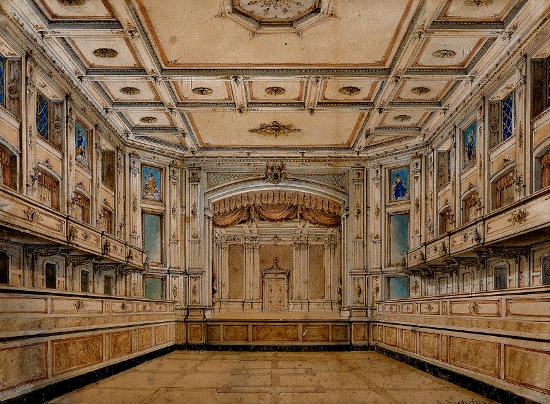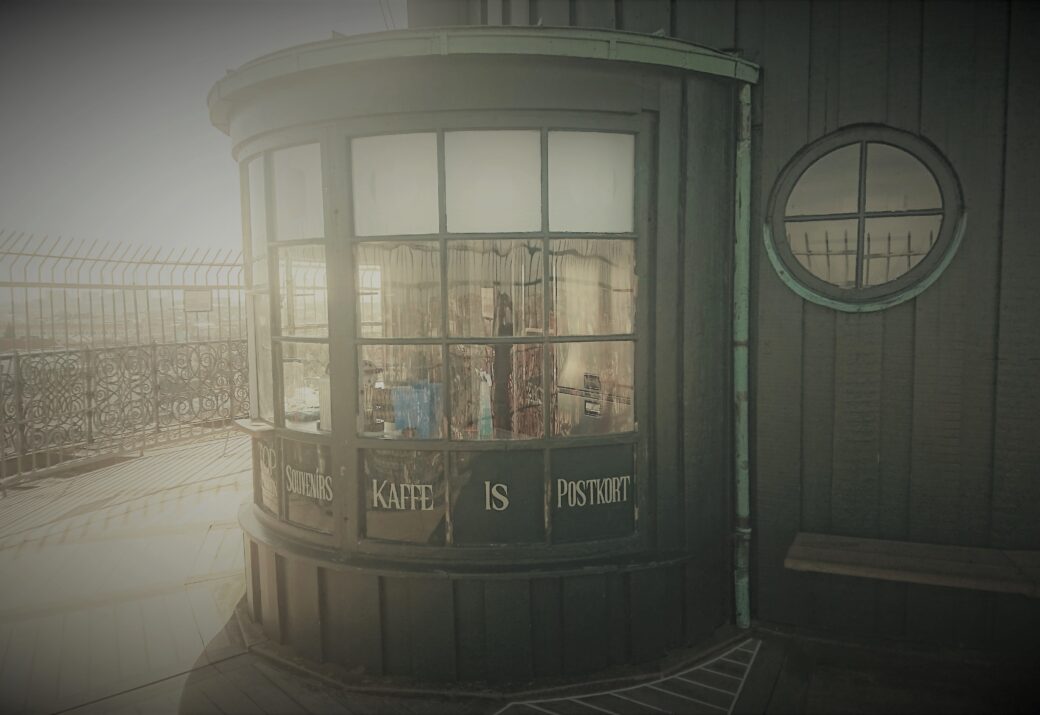This website uses cookies so that we can provide you with the best user experience possible. Cookie information is stored in your browser and performs functions such as recognising you when you return to our website and helping our team to understand which sections of the website you find most interesting and useful.
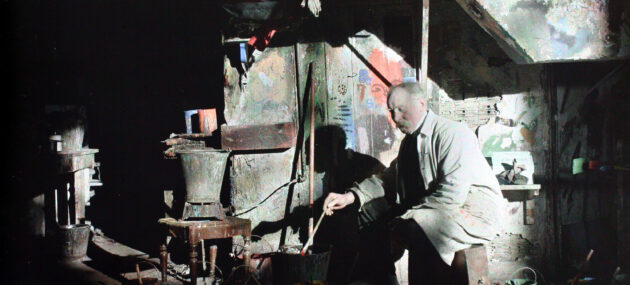
A Moving Picture
When The Great Danish Encyclopedia issued its sixth volume in 1996, the extensive national encyclopedia had reached the entry words “Erna” and “fracture” and all that was between the two – which included the entry word “farvefotografi” meaning “colour photograph” in Danish. A detailed graphic representation and a photograph depicting a man surrounded by paint buckets accompanied the short article.
The photograph was out on loan from the Round Tower’s collection and the tortuous road to here itself is a good story that leads us back to about 1910-12, when the picture was probably taken. It came about in the Round Tower, whose Library Hall at that time had long since been emptied of the University Library books and, instead, was used for varying purposes. During this period theatre-painter Carl Lund (1855-1940) used it as his studio.
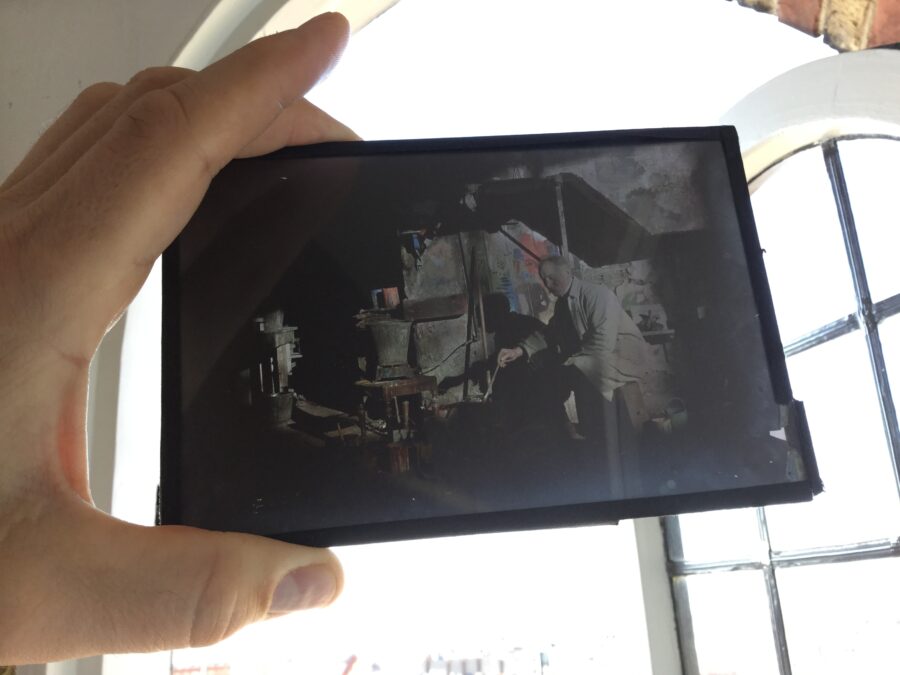
Scenery and Outdoor Decorations
Carl Lund’s studio, which was housed in the Library Hall from 1905 to 1927 and at times also expanded to the Bell Loft one floor above when more space was needed, supplied almost all of the capital city’s stages with backcloths and scenery, and also provided Tivoli among other places with imaginative outdoor decorations. His decorations were so popular that it became a figure of speech to say that, “Carl Lund has for the umpteenth time outdone himself”. Several regional theatres allegedly also used his name as advertising, even though he had not actually done the scenery.
Carl Lund was the leader of a thriving business that included several employees, dyers and painters among others. Thus, in a photograph from 1907 of the great studio above the Trinity Church, one can see several gentlemen in smocks standing upon an enormous canvas that is stretched out across the floor, which they, with the help of long paint brushes and in concentrated calmness, are in the process of transforming into Christiansborg Castle. If they were all wearing a bowler hat it could easily look like they were part of a surreal work by the Belgian painter René Magritte.
Potato Starch in Three Colours
One of these gentlemen was called Alfred Jepsen and it is he who has been allowed to sit down for a while in the colour photograph that appears in The Great Danish Encyclopedia. He was born in 1859 and was therefore a man in the prime of his life in 1910-12, but this did not prevent him from keeping up with the latest developments in colour photography, supposedly one of his great interests.
Photography had become much more widespread since the time when the Danish sculptor Bertel Thorvaldsen about 1843 found it necessary to make a sign with one of his hands to ward off the evil eye just as the camera snapped, and took what is known to be the oldest portrait photograph in Scandinavia. But colour photography had until recently been a slow process that was only possibly by hand-colouring or by photographing the same scene through three different colour filters and combining the pictures.
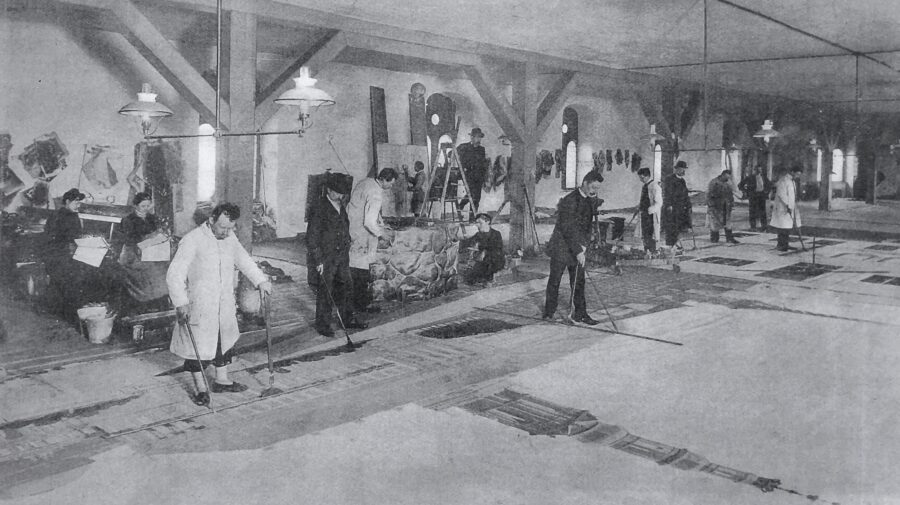
This was something the French brothers Auguste (1862-1954) and Louis Lumière (1864-1948) decided to change. They experimented assiduously with different methods of making colour photography, and finally in 1903 they reached a point where they could take out a patent on the so-called Autochrome plates. Autochrome plates were glass plates first coated with potato starch dyed red, blue and green and next with lampblack, and finally after this treatment the colour occurred by itself, so to say, on the photographic plate, which is what the word “Autochrome” literally means.
The Autochrome plates were seen as a revolution in photography since it was now possible to make colour photographs by a single exposure with ordinary cameras. The plates were put into production in 1907. As the first example of the exceptional invention, a colour photograph of the Danish King Frederik VIII and Queen Louise visiting Paris was published the same year in the magazine L’Illustration in no less than 90,000 copies.
A Historic Selfie
Thus, a few years later, the Autochrome plate had reached the Round Tower, where Alfred Jepsen used it for his historic selfie. Since Autochrome plates required longer exposures than their black-and-white colleagues, his grey hair, ruddy cheeks and expressive moustache consequently appear slightly faded against the razor-sharp background. Whether he has simply instructed how the picture should be taken, or taken it himself by using the self-timer we do not know, but it almost seems as if he is still in motion.
“However, the brothers did not believe in the future of film and chose to focus on colour photography instead”
In this way the photograph of Alfred Jepsen, which had to go all the way to Paris to be developed, is a moving picture. The term is usually reserved for film, for whose development the Lumière brothers also played a crucial role. In 1895 they shot a sequence of employees leaving the family’s factory in Lyon, which is often regarded as the first film ever been made. However, the brothers did not believe in the future of film and chose to focus on colour photography instead. If one compares the early film sequence and the early colour photograph, it certainly also seems to be an open question whether life is not radiating more intensely from the theatre-painter in the Round Tower than from the rapid movements of the characters in the silent film.
Alfred Jepsen lived right up until the 1950s and was over 90 years old when he died, long after the Autochrome plates had been replaced by new techniques. He did not just stay young with modern technology, but also by marrying a younger woman after his first wife had died. Before this woman died herself at the age of 109 in 1994, she had passed the Autochrome plate and its story to her nephew and his wife, who made sure that both came to the Round Tower. Back to where it all started.
